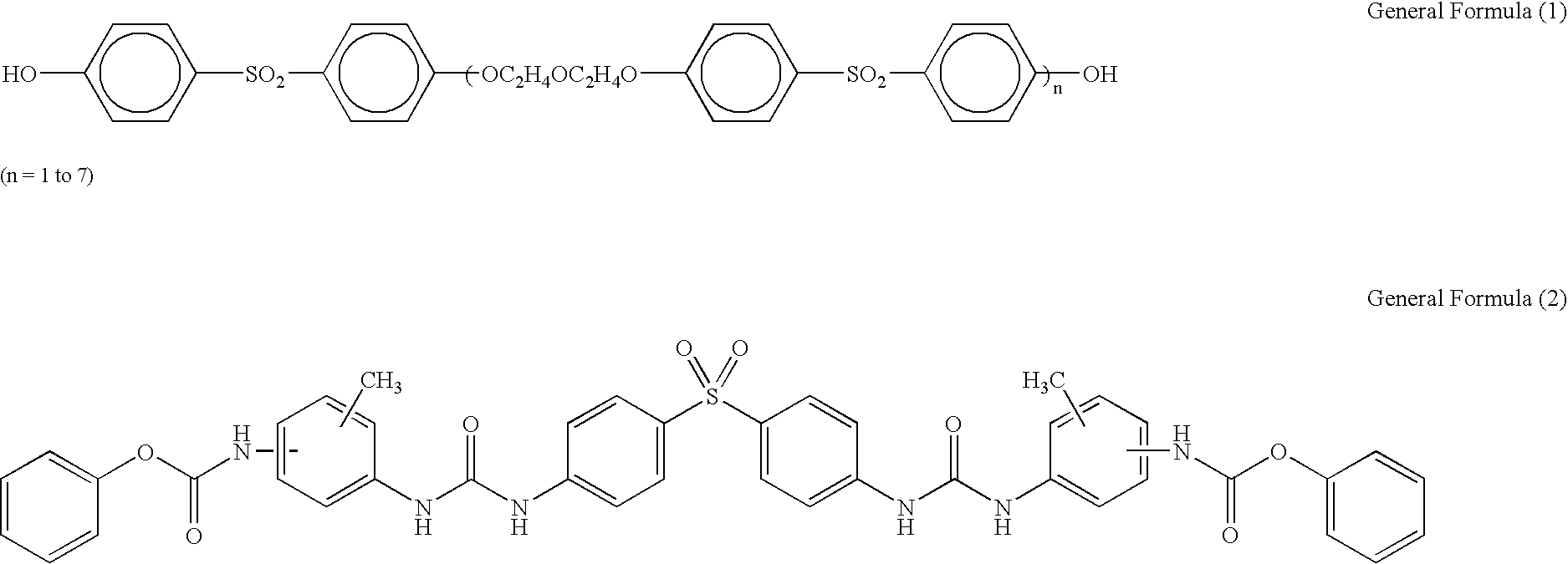Thermosensitive recording material
a technology of recording materials and vinyl chloride, which is applied in the direction of thermography, printing, duplicating/marking methods, etc., can solve the problems of insufficient use of vinyl chloride copolymer for low-torque printers represented, etc., to achieve excellent stampability, no shading, and low sticking
- Summary
- Abstract
- Description
- Claims
- Application Information
AI Technical Summary
Benefits of technology
Problems solved by technology
Method used
Image
Examples
example 1
Preparation of Thermosensitive Recording Layer
[0083]The two mixtures of ingredients shown below were milled and dispersed respectively for about 5 hours using a sand grinder to prepare A liquid and B liquid.
[0084]
A liquid3-(N-methyl-N-cyclohexyl)amino-6-methyl-20 parts7-anilinofluorane10% aqueous solution of polyvinyl alcohol (PVA)20 partsWater80 partsB liquidBisphenol S15 parts10% aqueous solution of polyvinyl alcohol25 partsSilica (Mizucasil P-527) *1)10 partsWater50 parts*1) by Mizusawa Industrial Chemicals, Ltd.
[0085]The A liquid and B liquid were then mixed in a mass ratio of 1:3 and the mixture was stirred to prepare a coating liquid of thermosensitive recording layer, which was then coated and dried on commercially available high-quality paper in an amount of 52 g / m2 (dried amount: 6.5 g / m2) using a laboratory coating machine to prepare a paper coated with a thermosensitive recording layer.
Preparation of Protective Layer
[0086]The two mixtures of ingredients shown below were m...
example 2
[0091]The thermosensitive recording material of Example 2 was prepared in the same manner as Example 1 except that the amount of the C liquid in the coating liquid of the protective layer was changed from 65 parts into 50 parts.
example 3
[0092]The thermosensitive recording material of Example 3 was prepared in the same manner as Example 1 except that the amount of the C liquid in the coating liquid of the protective layer was changed from 65 parts into 70 parts.
PUM
| Property | Measurement | Unit |
|---|---|---|
| volume average particle diameter | aaaaa | aaaaa |
| volume average particle diameter | aaaaa | aaaaa |
| particle diameter | aaaaa | aaaaa |
Abstract
Description
Claims
Application Information
 Login to View More
Login to View More - R&D
- Intellectual Property
- Life Sciences
- Materials
- Tech Scout
- Unparalleled Data Quality
- Higher Quality Content
- 60% Fewer Hallucinations
Browse by: Latest US Patents, China's latest patents, Technical Efficacy Thesaurus, Application Domain, Technology Topic, Popular Technical Reports.
© 2025 PatSnap. All rights reserved.Legal|Privacy policy|Modern Slavery Act Transparency Statement|Sitemap|About US| Contact US: help@patsnap.com

